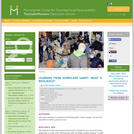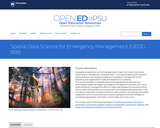
A good detective or researcher like Sherlock Holmes knows the fundamental questions that need to be answered to gather facts to solve a problem. So how does geospatial intelligence contribute to answering these questions? While geospatial technology is useful in revealing who, what, when, and where events take place, it is less useful in explaining why events occur. However, geospatial intelligence analysis leverages geographic information science and technology with the intelligence tradecraft to develop products that support decision-making in national and homeland security, law enforcement, emergency management, and international relief efforts. GEOG 882 will challenge you to think critically, consider alternative viewpoints, and question your own assumptions when analyzing why human events occur over place and time.
- Subject:
- Applied Science
- Business and Communication
- Communication
- Cultural Geography
- Information Science
- Physical Geography
- Physical Science
- Social Science
- Material Type:
- Full Course
- Provider:
- Penn State College of Earth and Mineral Sciences
- Author:
- Mark Corson
- Date Added:
- 10/07/2019




